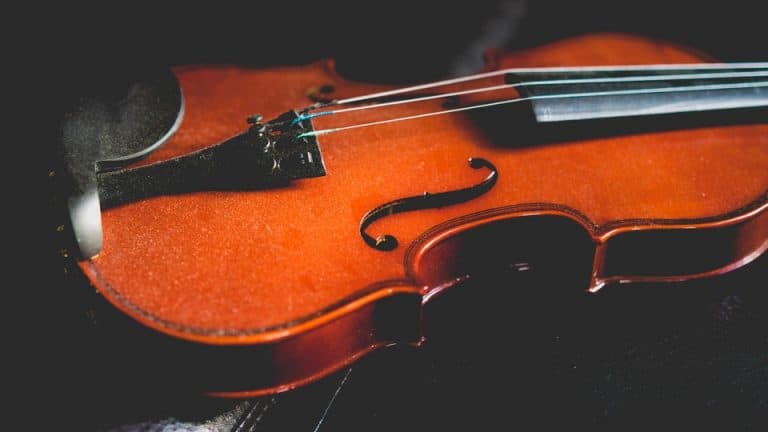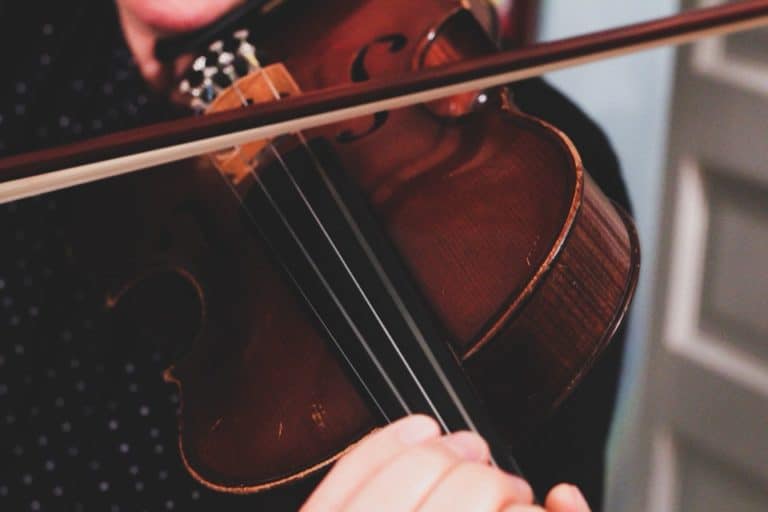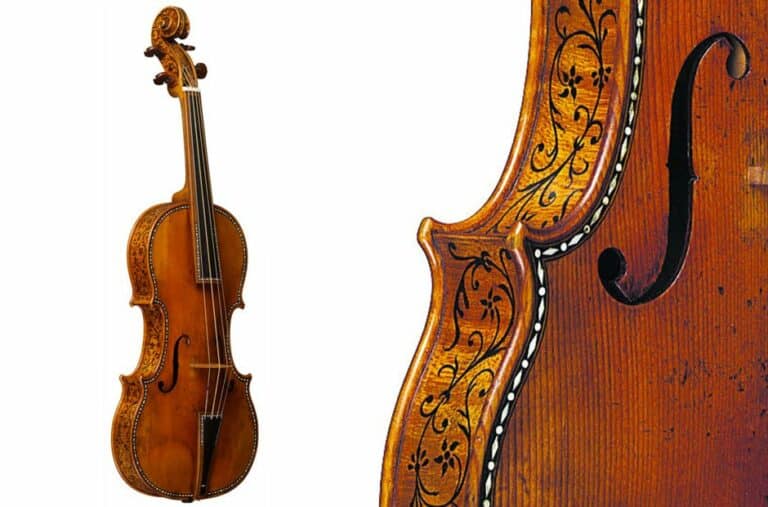What are Violins Made out of? (Including Secret Materials)
Violins are somehow mythical instruments that can be expensive. Stradivarius violins can even cost up to many millions of dollars. And they sound so wonderfully in the hands of our virtuosi. So what are violins made out of?
Violins and string instruments are made out of Spruce wood for the top, Maple for the bottom, and neck. This choice of wood is made for sound. The fingerboard is made out of Ebony for its sturdiness. Then, accessories such as pegs, tailpiece, and chin rest are made out of Ebony, Rosewood, Maple, or even Boxwood. Some parts such as the chin rest and button are even made out of synthetics materials now.
But there are many other parts in a violin, and each of them plays an important part. So what are they made of?
What wood are violins made of?
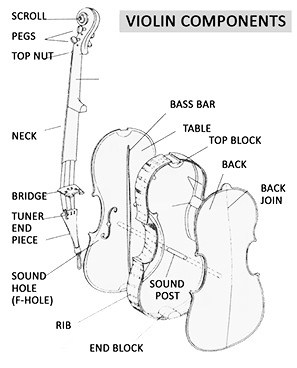
But to plainly understand what materials are chosen and used to make a violin, one must understand the role each part plays to produce the sound.
The different parts of a violin are detailed in the picture for further reference.
Keep in mind that for the body of the instrument, every wood is chosen with sound in mind.
For accessories, practicality, durability, price, and aesthetics are also considered.
The body of the instrument is the part that vibrates to produce sound. It serves the purpose of a sound box that amplifies naturally the sound of the instrument.
I have detailed in this lengthy article how the sound is made on a violin. But in a nutshell, keep in mind that the violin has to amplify both low and high-pitch notes in the same soundbox form-factor without going into resonance on a single frequency.
The bridge has the low-pitched strings on the left, with the left foot of the bridge resting on the bass bar, transmitting the sound to the top of the instrument.
The bridge as the high-pitched strings on the right, which the right foot of the bridge resting on the soundpost, transmitting the sound to the bottom of the instrument.
That is why the top and the bottom of the violin are made out of different woods, with different physical thus tonal qualities, in order to amplify low-pitched notes as well as high-pitched ones.
The top of the body of a violin is made out of spruce.
Spruce is a hardwood made of trees of the same family of pine. Those trees are carefully chosen among trees that have slowly grown in altitude with long winters in order to get heavy and hardwood. Trees that have grown quickly in a hot and humid climate or not good to make violins.
Spruce wood has the quality of being hard, not too much, but at the same time supple. The top is carved quite thin to vibrate more.
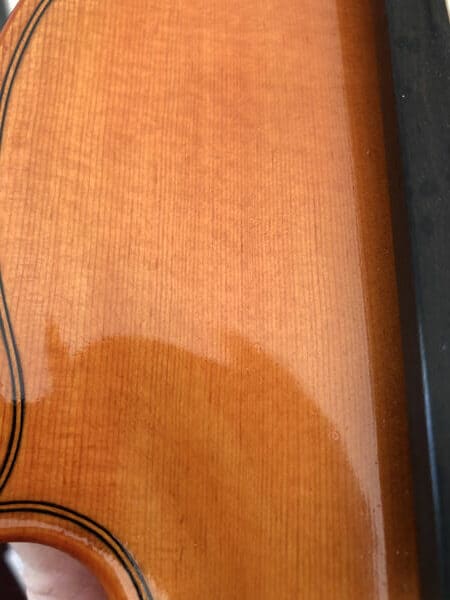
The grain, or ring, of the wood, go lengthwise; spruce is cut in a longitudinal fashion. That allows vibrations to go laterally.
The ring of the wood is not too tight to allow low-pitched notes to be amplified through the longest and slowest wood vibrations.
Best violins have a choice of irregular growth rings: the rings go from wider on the left side of the top – the side of the lower-pitched strings – to tighter on the right side of the top – where the higher-pitched strings rest upon. That is the top choice of wood, and only the best luthiers and the most expensive instruments are build that way. Such a top is beautiful to the well-informed eye.
The bass bar is made of spruce.
The bottom of the violin is made of maple.
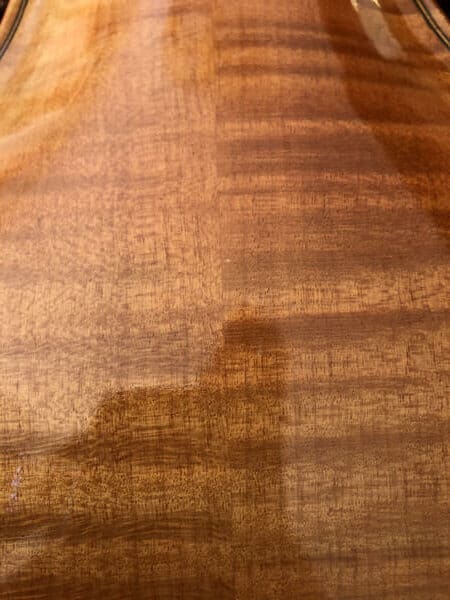
If you have followed closely, you remember that the bottom of the violin has to amplify the treble part of the spectrum, that is to say, high-pitched notes.
So the bottom is carved out of heavier and denser maple wood. With a heavier wood with a tighter ring, this piece tends to vibrate quickly, thus allowing the short and fast treble vibrations to resonate.
The soundpost of string instruments is made of spruce
The soundpost is an important part of a violin. It supports the tension between the top and the bottom of the instrument, but it also transmits the treble high-pitched frequencies to the bottom part of the violin.\
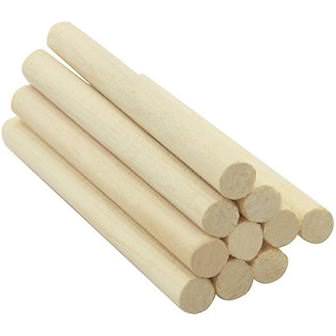
The soundpost is turned out off a piece of spruce, which is light though rigid and dense enough for the purpose. The type of wood is not as important as the diameter of the soundpost. The smaller the diameter, the more medium and low is amplified. But spruce is always the choice of wood.
The neck is made of Maple
Maple wood is once again dense and strong. It is perfect for a neck. It transmits vibrations while being sturdy. The neck is usually not varnished.
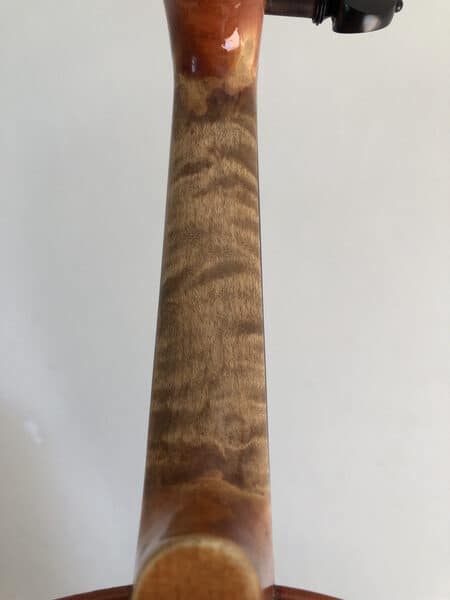
The ribs of the violin or viola are made of maple
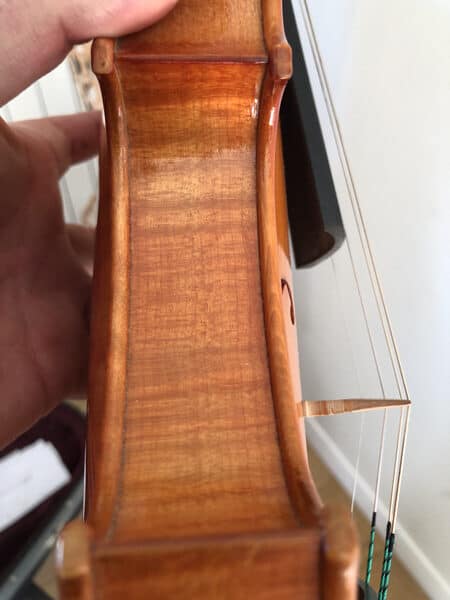
A bit like the bottom, the ribs need to be heavier and denser because they support the tension between the top and bottom. Maple is stronger: construction-wise and for the sake of the sound also, it is maple wood that is chosen.
The fingerboard of a violin is made of Ebony or Rosewood
The fingerboard of a violin is usually made of Ebony. Ebony is a wood that is:
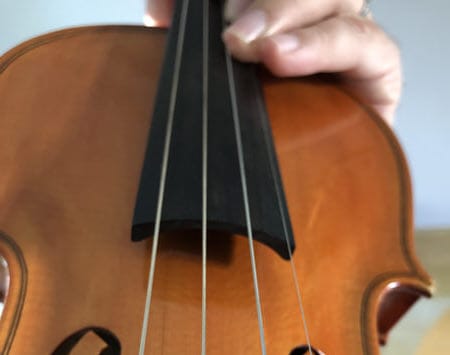
- very dense: it bears thousand hours of playing without being worn out. Fingers (and strings) do not mark easily on this wood. It is particularly hard and durable. If there are finger marks eventually, it is easy enough to plane the fingerboard by shaving a small amount of wood.
- because Ebony is completely black, there is no need to protect or varnish the fingerboard. The numerous impact of the fingers, whether clean, oily, dirty do not leave any traces on the wood. Ebony is always clean.
But Ebony can be expensive. Cheaper violins can have their fingerboard made out of Rosewood, which can be considered a cheap Ebony because it is almost as dense, almost as dark, almost as hard (but not as good…)
On even cheaper violins, I have seen fingerboards made out of maple painted in black. So it looks ok when new. But it gets worn out far quicker, the black paint has a tendency to fade. And you can’t plane a maple fingerboard without painting it again.
The Bridge is made out of Maple and sometimes Rosewood
The bridge is the last important part of the violin sound-wise. It supports the tension of the strings and transmits the vibrations to the top table and the bottom of the violin. So it needs to be dense and strong.
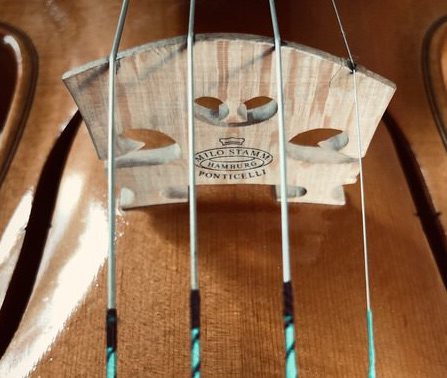
The wood which is the most commonly used is Maple wood.
But many violins, violas, cellos, or double bass bridges are made out of Boxwood, a beautiful and dense wood, with interesting rings. Boxwood grows really slowly and is dense. It allows the tools of the craftsman to carve precisely through it and is hard and durable. It sounds great also.
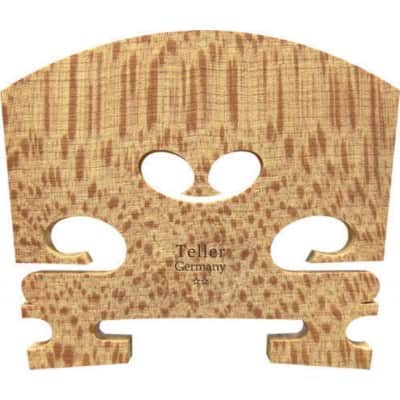
The best bridges are made out of parts of the wood where the growth rings structure meets perpendicularly the vascular structure where the sap of the tree flows. After centuries of trial and error, luthiers have found that it gives the best sound to the violin.
The varnish
The varnish is the last touch to finish an instrument. It protects the wood while allowing the wood to breathe and vibrate at the same time. There are two types of varnish:
- with a base of oil: usually linseed oil. The oil needs to be able to dry. Resin is usually added to the oil with natural-colored pigments to give its aspect to the violin.
- with a base of alcohol: Again, the alcohol is a base where natural pigments are dissolved to give the violin its particular color. Pigments are usually iron oxide, mercury sulfate.
Other parts of the violin and viola: what are they made of?
What follows now is more considered as accessories. They can play a part in tone production as well, but not as much. That is why there can be a greater variety of materials used to make them.
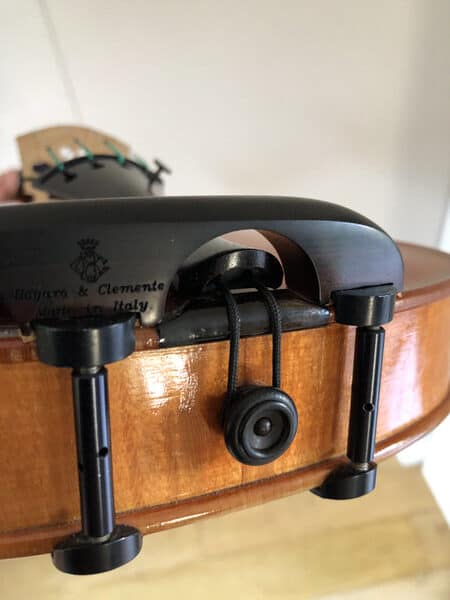
Chinrest: Boxwood, Maple, Ebony, Synthetic materials, Rosewood…
The chin rest can be made out of many materials. Chinrests are not important for the sound. It has to be comfortable, sturdy, not allergenicity because it will be in contact with the chin for many hours. It used to be principally made out of ebony; now it can be made out of synthetic materials more often for their price and weight. Sometimes Rosewood or Boxwood is chosen for aesthetics (and coordinated colors with the tailpiece and pegs).
Tailpiece: Boxwood, Maple, Ebony, Synthetic materials, Rosewood…
The tailpiece is not as important to produce the sound. It has to be dense and light as well. Some have experimented with different materials sound-wise: but there is not a clear winner in the material recommended to make tailpieces.
A bit like chin rests, different materials are used, depending on the price, the looks, the sound. Again, many violinists like to coordinate their tailpiece with their pegs and chin rest.
Tail cord: kevlar, nylon, gut
The tail cord secures the tailpiece to the button. Tail cords used to be made out of gut. But because of the instability of the material (highly dependable on differences in hygrometry and temperature), it is now preferred by kevlar or nylon.
Button: Ebony or Boxwood, even Synthetic material
The button is traditionally made out of ebony for its great sturdiness and matching color with the fingerboard.
Again, the button can be made out of Boxwood to match other parts of the instruments. And it is cheaper.
Pegs: Boxwood, Maple, Ebony, Rosewood…
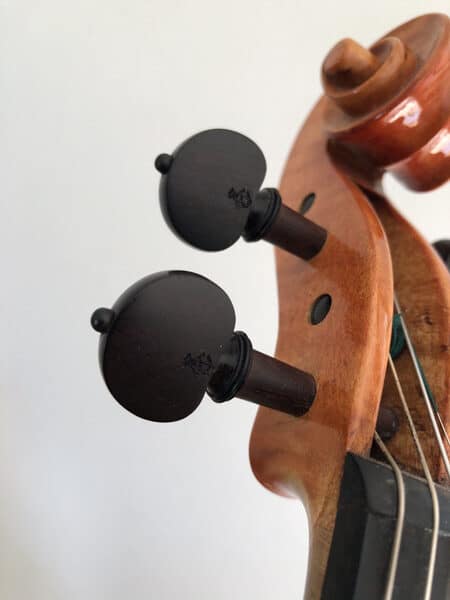
Pegs need to be hard, and shouldn’t wear too easily. They can be made out of Ebony, but more often out of Rosewood or Boxwood. It is beautiful when they match the tailpiece and chin rest. They do not have a strong influence on sound, if any. Cheaper instruments can have synthetic pegs, but it is definitely lower quality and it is not recommended as synthetic pegs tend to turn too easily.
What are Stradivarius violins made out of?
Stradivari violins have become a myth. Many lose their reason with these instruments. They are a bit like Mona Lisa or the 16th Chapel: they are part of our collective History with a capital H.
But yet, they are violins. And Stradivari violins are surely the most analyzed and copied instruments of all times. So we know them quite well on the contrary. It is not that Stradivarius violins are made out of different materials than other violins, it is that, counter-intuitively, all violins try to use the SAME material as Stradivarius violins!
So the explanation of the magic of these violins can be the subject of many books, studies, and articles.
But a couple of points, though. It has been said, for example, that Antonio Stradivari used the wood of Spruce and Maple from the Alps, corresponding with the small ice-age, resulting in denser woods. But his instruments were made out of Spruce and Maple as well.
What is not known, though, is the recipe of his varnish. We know almost all the ingredients, but not how he made it and applied it to the instruments. Stradivarius varnish was an oil type varnish with iron oxide, mercury sulfate, and cochineal pigments among others.
What are violins made of today?
There are not many differences when we look at what violins are made out of now.
For sure, the cost is considered and many more types of material are available than a century ago. But everything has been tried to improve the sound of that instrument. That is why, when it comes to sound, modern violins don’t deviate much from how old violins were made. Especially good quality ones where price doesn’t matter.
For any part that is less important to sound, synthetic materials are more and more preferred to noble woods: pegs, tailpiece, chin rest, buttons are a great example of that. The tail cord is often made of kevlar for its robustness: it doesn’t expand and allows the tuning to be more stable.
Noble materials are always preferred to make pricy instruments for their look and feel.
Cheaper instruments make more extensive use of synthetic materials and less noble wood (for example Rosewood and Maple instead of Ebony).
At the end of the day, close your eyes and listen. Only the sound matters…


